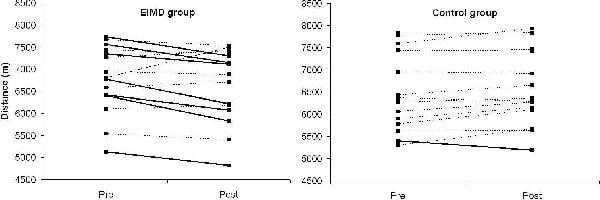Exercise-induced muscle damage (EIMD) is known to decrease muscle strength and power, but its effects on endurance performance and running economy are unclear (1-4). The main aim of this study was to determine whether EIMD impairs running performance in a 30 min time trial. Thirty runners (24 men and 6 women, age 31 ± 9 years, [vdot]O2max 54.1 ± 6.0 ml/min/kg) were matched for gender and randomly assigned to an EIMD or control group. Subjects in the EIMD group jumped 100 times from a 35 cm bench while controls did not perform any muscle-damaging exercise. Before and 48 hours after experimental treatment, subjects were tested on (1) markers of muscle damage, (2) steady-state cardiorespiratory, metabolic and perceptual responses during a constant speed run at 70% of [vdot]O2max, and (3) distance ran in 30 min on a treadmill. Two-way (group x test) mixed ANOVAs were used for group analyses. Individual changes in performance were analysed using the Reliable Change Index (5). All markers of EIMD were significantly affected by experimental treatment: delayed-onset muscle soreness increased 4 points on a 0-6 scale, serum CK increased from 159 to 332 IU/l, knee extensors strength was reduced by 12% (all P < 0.01). EIMD significantly reduced 30 min time trial performance by 4% (P < 0.01) with 7 subjects in the EIMD group showing a reliable decrement in performance compared to only 1 in the control group (Fig. 1). Running economy and other physiological responses to submaximal running were not affected by EIMD (Table 1). However, a trend for increased perceived exertion was found. EIMD has a negative impact on endurance running performance in humans despite no changes in running economy. Further studies on the central and peripheral factors mediating fatigue in subjects with EIMD are warranted.
University College London 2006 (2006) Proc Physiol Soc 3, PC129
Poster Communications: Exercise-induced muscle damage impairs endurance running performance in humans
Samuele Marcora1, Andrea Bosio1
1. School of Sport, Health and Exercise Sciences, University of Wales-Bangor, Bangor, Gwynedd, United Kingdom.
View other abstracts by:
Figure 1. Individual changes in time trial performance. The bold lines represents a reliable decrease the dashed lines represents a reliable increase and the dotted lines represents a non-reliable change.
Table 1. Effects of experimental treatment on responses to running at 70% of [vdot]O2max (EIMD = 11.6 ± 1.4 km/h Control = 11.2 ± 1.4 km/h)
Where applicable, experiments conform with Society ethical requirements.


![Table 1. Effects of experimental treatment on responses to running at 70% of [vdot]O2max (EIMD = 11.6 ± 1.4 km/h Control = 11.2 ± 1.4 km/h)](https://static.physoc.org/app/uploads/2019/01/22203614/PC129_T1.jpg)